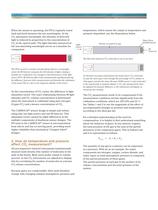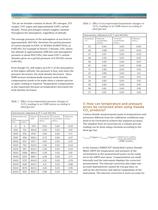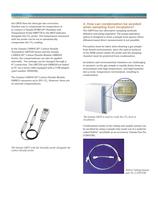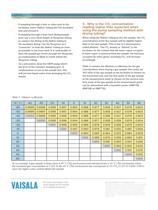 Website:
VAISALA
Website:
VAISALA
Catalog excerpts

PRIMARY IMAGE AREA / APPLICATION NOTE INCUBATORS SEPTEMBER 2009 CO2 Measurement in Incubators - Questions and Answers The purpose of this document is to answer most frequently asked questions often proposed concerning CO2 measurement and products. 1. How does the CARBOCAP®, NDIR (non-dispersive infrared), single-beam, dual wavelength sensor work? The Vaisala CARBOCAP® Sensor has three major components: a light source, an interferometer, and an IR detector. The light source is positioned to shine at the IR detector so that the light travels a fixed distance to the detector, where the intensity of the light is measured. Frequently asked questions 1. How does the CARBOCAP®, NDIR (non-dispersive infrared), single beam, dual wavelength sensor work? 2. How do temperature and pressure affect CO2 measurement? 3. How can temperature and pressure error be corrected when using Vaisala CO2 products? 4. How can condensation be avoided when sampling from incubators? 5. Why is the CO2 concentration reading higher than expected when using the pump sampling method with drying tubing? Light source Volume occupied by gas Fabry Perot Interferometer IR Detector At the CO2 absorption wavelength, light is absorbed by the carbon dioxide present in the gas. The FPI tunes out of all other wavelengths, so the intensity of light reaching the IR Detector varies as a function of the amount of CO2 within the sensor. A Fabry-Perot Interferometer (FPI) is positioned just in front of the IR detector. The FPI is a tunable filter which allows only certain wavelengths of light to pass through to the detector. Carbon dioxide absorbs certain wavelengths of light and not others, so the FPI is designed to pass light at a CO2 absorption wavelength (4.26 ìm) and a nearby, non-absorbing wavelength. See the illustration on the left.
Open the catalog to page 1
The FPI is tuned to a nearby non-absorbing reference wavelength, where the IR Detector measures the full intensity of light, creating a baseline for comparison. Any changes in the performance of the light source, FPI or IR Detector, affect both measurements equally, preserving the difference between both measurements and therefore the calibration of the sensor. This is a key to the long-term stability of the sensor. As the concentration of CO2 varies, the difference in light intensities varies. The exact relationship between IR light intensity and CO2 volume concentration is determined when...
Open the catalog to page 2
The air we breathe consists of about 78% nitrogen, 21% oxygen, 0.9% argon and approximately 0.04% carbon dioxide. These percentages remain roughly constant throughout the atmosphere, regardless of altitude. The average pressure of the atmosphere at sea level is approximately 1013 hPa, therefore the partial pressure of carbon dioxide is 0.04% of 1013hPa (0.0004*1013), or 0.405 hPa. For example in Denver, Colorado, USA, where the altitude is approximately 5280 feet and atmospheric pressure is about 834.3 hPa, that same 0.04 % carbon dioxides gives us a partial pressure of 0.334 hPa versus...
Open the catalog to page 3
4. How can condensation be avoided when sampling from incubators? The GM70 has two alternative sampling methods: diffusion and pump-aspirated. The pump-aspiration option is designed to draw a sample from spaces where diffusion-based direct measurement is not possible. Precaution must be taken when drawing a gas sample from humid environments, since the optical surfaces of the NDIR sensor inside the probe and the pumping chamber must be protected from condensation. Incubators and environmental chambers are challenging to measure, as the gas sample is usually drawn from an environment with...
Open the catalog to page 4
The core technology of the tubing is Nafion®1 that is highly selective in the removal of water. The water moves through the membrane wall and evaporates into the surrounding air in a process called perevaporation. Nafion® removes water by absorption which occurs as a First Order kinetic reaction. In drying applications, the moisture exchanger transfers water vapor from a wet gas stream into the surrounding atmosphere. Drying is complete when the sample humidity level is equal to the ambient humidity level. Since drying proceeds as a First Order kinetic reaction, this level can be reached...
Open the catalog to page 5
- If sampling through a hole or other port in the incubator, insert Nafion® tubing into the incubator and seal around it. - If sampling through a hose barb fitting/sample port, use a very short length of Neoprene tubing to connect the fitting of the Nafion tubing to the incubator fitting. Use the Neoprene as a “connector” to hold the Nafion® tubing as close as possible to the hose barb. It is undesirable to have the sample gas travel through the Neoprene, as condensation is likely to result within the Neoprene tubing - As a precaution, keep the GM70 pump above the level of the chamber...
Open the catalog to page 6All VAISALA catalogs and technical brochures
-
OPT100 Optimus™ DGA Monitor
4 Pages
-
DMP6 Dew Point Probe
2 Pages
-
GMP252 Carbon Dioxide Probe
3 Pages
-
Vaisala weather radars
4 Pages
-
Weather Radar WRK200
3 Pages
-
Indigo 520 Transmitter
2 Pages
-
CO₂ Transmitter Series GM20
2 Pages
-
MGP261 Multigas Probe
2 Pages
-
GMP251 Carbon Dioxide Probe
3 Pages
-
Indigo 520 Transmitter
2 Pages
-
DL4000 Universal Data Logger
2 Pages
-
MMP8 Moisture in Oil Probe
2 Pages
-
TMP1 Temperature Probe
2 Pages




























































